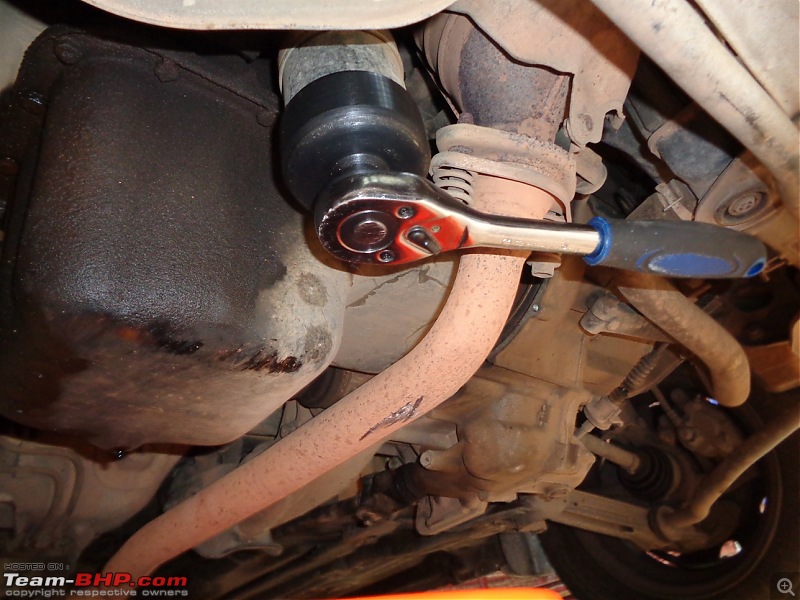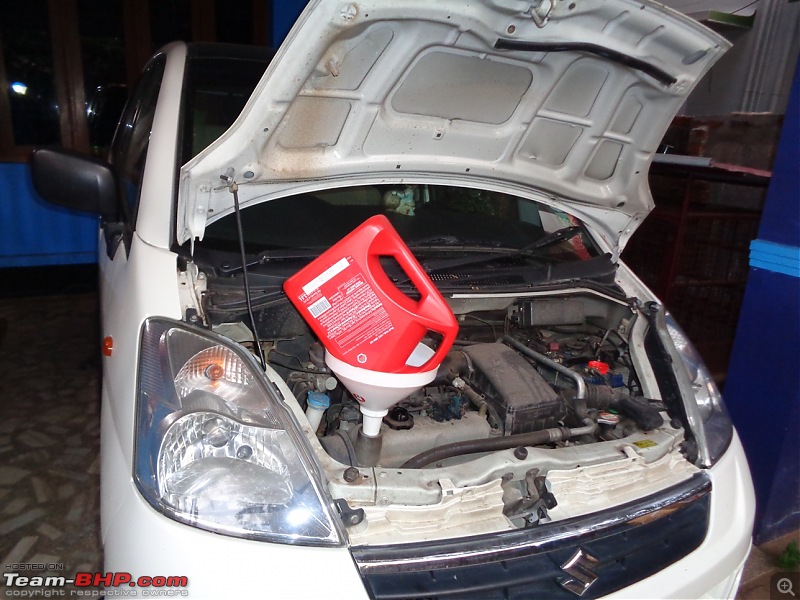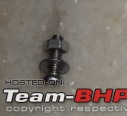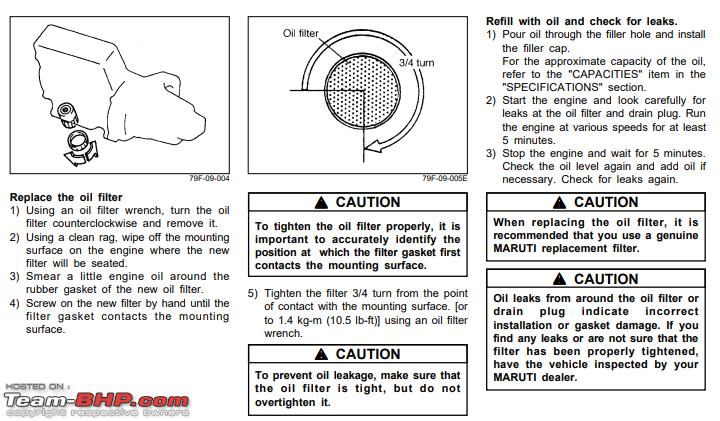| |||||||
| Search Forums |
| Advanced Search |
| Go to Page... |
 |
| Search this Thread |  55,318 views |
| | #1 |
| BANNED Join Date: Nov 2016 Location: Kollam
Posts: 2,018
Thanked: 6,647 Times
| DIY: Maruti-Suzuki F10D Engine Oil Change Hey guys, so happened to change my mom's car's engine oil and thought I'd make a DIY post about it since I couldn't find a single one online pertaining to the F10D in spite of the motor being used in models such as Alto 1.1,Wagon R and Zen Estilo to the best of my knowledge. Specifications:
Requirements:
Procedure:




 This is one of those things that costs anywhere from 200~500/- for labor when done at a workshop, but being an enthusiast it is not a matter of money but pride changing ones own oil.  Last edited by GTO : 29th March 2018 at 09:59. Reason: Removing 'bold' from captions - thanks for sharing! |
| |  (42)
Thanks (42)
Thanks
 |
| The following 42 BHPians Thank ashwinprakas for this useful post: | a4anurag, amitjha086, arun_josie, ashis89, audioholic, blackwasp, comfortablynumb, Crazy_cars_guy, DrANTO, E = mc≤, francis_vaz, govigov, Grand Drive, GTO, HappyWheels, haria, hmansari, ilangop, jnanesh, karthikd21, Kpzonwheels, ksameer1234, lemedico, Leoshashi, libranof1987, lrsays, MAKMADDY17, mp417, Omkar, paragsachania, Prathiiik, prithm, procrj, R2D2, Researcher, sri2012, sukiwa, The Rationalist, Turbohead, Varun_HexaGuy, vsaravind007, W.A.G.7 |
| |
| | #2 |
| BHPian Join Date: Jan 2015 Location: MAA - HYD
Posts: 669
Thanked: 713 Times
| re: DIY: Maruti-Suzuki F10D Engine Oil Change |
| |  (4)
Thanks (4)
Thanks
 |
| The following 4 BHPians Thank prithm for this useful post: | a4anurag, audioholic, Crazy_cars_guy, hmansari |
| | #3 | ||
| BANNED Join Date: Nov 2016 Location: Kollam
Posts: 2,018
Thanked: 6,647 Times
| re: DIY: Maruti-Suzuki F10D Engine Oil Change Quote:
 Quote:
| ||
| |  (2)
Thanks (2)
Thanks
 |
| The following 2 BHPians Thank ashwinprakas for this useful post: | a4anurag, DrANTO |
| | #4 |
| Distinguished - BHPian  | re: DIY: Maruti-Suzuki F10D Engine Oil Change Thanks, nice write up. Doing these sort of jobs yourself can be very rewarding. A few suggestions, maybe you did, cant make out from your description. I would always place a piece of cloth across the open oil cap. You dont want anything accidently falling into your engine! Very costly and time consuming! I know, it has happened to me!! The plug for the drain in the sump usually has a copper ring as a seal. Replace it, or if you want to use the old one; heat it untill red hot and throw it in cold water. The copper will be literally as good as new as this simple process will restore the elasticity. It it has a rubber ring I would always just replace it. The last thing you want to have is an engine filled with nice new and expensive oil and it leaking out of the drain plug because its not properly sealing. Before installing the new oil filter also fill it with oil. That is beneficial for the first start of the engine after the oil change. Without oil the oil pump will have to swallow a bit of air and that goes directly into the engine lubrication system, so effectively less lubrication for a very short while. Nothing major to worry about, but if you can always fill the new oil filter before installing. Jeroen Last edited by Jeroen : 28th March 2018 at 21:50. |
| |  (32)
Thanks (32)
Thanks
 |
| The following 32 BHPians Thank Jeroen for this useful post: | a4anurag, Abhi_abarth, arun_josie, ashis89, ashwinprakas, digitalnirvana, DrANTO, Eddy, GTO, HappyWheels, haria, hmansari, ike, iron.head, KA18, karuvally, Leoshashi, libranof1987, moralfibre, Nohonking, paragsachania, Prathiiik, RavenAvi, recshenoy, Researcher, saket77, samabhi, satishv1987, SS4, The Rationalist, vaasu, VaibhaoT |
| | #5 | ||
| Distinguished - BHPian  | re: DIY: Maruti-Suzuki F10D Engine Oil Change Quote:
Quote:
 Not sure about the type of metal used, but in my opinion, it should never be re used. Regards, Shashi | ||
| |  (12)
Thanks (12)
Thanks
 |
| The following 12 BHPians Thank Leoshashi for this useful post: | arun_josie, ashwinprakas, baby_antu, DrANTO, GTO, HappyWheels, karuvally, lemedico, MAKMADDY17, paragsachania, Prathiiik, sumitsinha0280 |
| | #6 | |||
| BANNED Join Date: Nov 2016 Location: Kollam
Posts: 2,018
Thanked: 6,647 Times
| re: DIY: Maruti-Suzuki F10D Engine Oil Change Quote:
 Jokes apart, yes I do make it a habit to cover the oil window with cloth on both cars as well as motorcycles, used to own a ZMA and the parts were both expensive and scarce so I brainstorm of all things that could go wrong before working on the motorcycle, guess the habit stayed. Quote:
Quote:
| |||
| |  (5)
Thanks (5)
Thanks
 |
| The following 5 BHPians Thank ashwinprakas for this useful post: | a4anurag, DrANTO, GTO, HappyWheels, paragsachania |
| | #7 | |
| Distinguished - BHPian  | Re: DIY: Maruti-Suzuki F10D Engine Oil Change
There is a fine line between paranoid and experience.  Many people will not think of things, just because it never happened to them and the likelyhood of it happening isnt all that apperent. It has happened to me. I knocked over a small bowl with bolts and nuts that had been sitting on the air filter and the oil cap was off. I picked up all bolts and nuts and noticed one nut was missing. I spent at least half an hour inspecting the engine bay, the garage floor and so. All to no avail, so my conclussion was it had fallen in. So it meant checking taking the camshaft cover off and the sump where I eventually found it. So never keep your parts and pieces on the egine!. If you must use magnetic trays! Many people will not think of things, just because it never happened to them and the likelyhood of it happening isnt all that apperent. It has happened to me. I knocked over a small bowl with bolts and nuts that had been sitting on the air filter and the oil cap was off. I picked up all bolts and nuts and noticed one nut was missing. I spent at least half an hour inspecting the engine bay, the garage floor and so. All to no avail, so my conclussion was it had fallen in. So it meant checking taking the camshaft cover off and the sump where I eventually found it. So never keep your parts and pieces on the egine!. If you must use magnetic trays!In my merchant navy days I have had worse. One day we were inspecting the gear teeth on the main gear box. These are huge gear boxes as the main gear has a dimension of well over 125cm! There is a small cover on top of the gear box for just this purpose. My second engineer was helping and he was using his torch to get some extra light. All of a sudden, without warning the front of his torch, followed by two batteries fell off and went straight into the gearbox!! There are no inspection covers or anythign at the bottom of the gear box. So we had to get a specialised company with some very clever cameraas and tools to help us get everything out again. Apart from a huge embarrassement it was also quite expensive as we lost a day worth of charter money as we were not operational anymore! So from then on whenever working near openings in engines and gearboxes I made sure none of us had anythign on us that could become loose. No watches, no bracelets, necklaces, empty out pockets and for God Sake check the damn torches! Quote:
On most engines the oil pump will draw from the sump through some type of strainer. Usually just a fairly wide mesh kind, just to catch any major debris from getting into the oil pump. The oil pump pums oil out into the filter and from the filter it will go to the gallerie. When you stop an engine, oil is left in the bearings and all over de various parts. Taking the oil filter off doesnt change that. So normally when you start an engine there is sufficient oil left for those initialy few seconds upon starting. Also the pump, all supply line and the filter typically remain more or less filled. If you do not fill the new filter with oil, you effectively will pump air into the gallerie and thus the bearing. As the oil pumps starts rotating it will push fresh oil into the filter that is filled with air. The only place the air can go to is to the gallerie and thus the bearings. Now, initially there is still a film of oil left on the bearings, but as that airpockets gets dispersed through the gallerie and the various outlets to bearings and so, you effectively are blowing a bit of air into the bearings instead of oil. Look at your oil cannister, but it could be a volume of 200-450ml easily. You can check for yourself. Just notice when you start your engine how quickly the oil pressure gauge will register normal or oil pressure light extinguishes. It is near immediate upon starting. Now replace the filter without filling and observe the same. You will notice it can take up to 2-3 seconds before the oil pump has built up normal pressure. That is because it has to push the air pocket our first. Next oil change, fill the filter prior installation and you will notice that the 2/3 seconds will most likely halve. You will still notice a slight delay to normal starting, but it will be notable less than with an unfilled new filter. To your point, does it matter. Its one of these car forum topics that is debated heavilly and usually has two streams of dedicated followers. Those who do not fill and those who do fill. The do not will claim they have never seen any adverse affects and so do the do fillers. There is no way to prove it. And of course, it all takes place in less than 1/2 second, at idle during each oil change. But here is my thinking. The larger engines get, the bigger the effect is going to be. Very simply put, a larger engine in size, will have larger bearing surfaces, larger sump and a larger filter volume. Bearing surface is a function to the power of 2, but volume is to the power of 3. So the effect on larger engines of leaving air in the filter is increasing rapidly. Im also still an engineer at heart. I dont see why an engine, any engine, should run with suboptimal lubriciation even for a second. Especially, if it takes virtually no effort on my part. I'm there hovering over the engine with my tools, my new filter and my new fresh oil. Filling the filter prior to installation might take 10/15 seconds, so why not" Also, I still have various official workshop manuals that actually stipulate that this is the correct procedure, but it does vary a bit from manufacturer to the next. I still do it on all types of filters, the ones with a fixed filter housing, rather than the cannister, such as my Mercedes 123. See http://www.team-bhp.com/forum/diy-do...ml#post4156444 But also on my Jagaur where the filter cannister is mounted horizontally. Obvioulsy, you cant fill it completely as the oil will run out when you tilt it. But about 1/3 works as well. See http://www.team-bhp.com/forum/diy-do...ml#post4224354 Final note on the new oil filter, only tighten by hand, no tools Jeroen Last edited by Jeroen : 29th March 2018 at 12:19. | |
| |  (14)
Thanks (14)
Thanks
 |
| The following 14 BHPians Thank Jeroen for this useful post: | abhi9044, Arvi95, ashwinprakas, BigBrad, digitalnirvana, haria, hmansari, karuvally, Leoshashi, PearlJam, RavenAvi, Researcher, satanic_dude, sukiwa |
| | #8 |
| Team-BHP Support  Join Date: Sep 2010 Location: All over!
Posts: 7,910
Thanked: 19,737 Times
| Re: DIY: Maruti-Suzuki F10D Engine Oil Change Simple yet highly rewarding (the pride you talked about) DIY, thanks for sharing! If you intend to carry out such DIYs (and more), I'd strongly suggest getting a couple of jack stands so you can easily (and safely) raise your car. Driving over the spare tyre and using it to prop your car isn't safe, and will damage the spare tyre/rim. https://www.amazon.in/Big-Bull-Ton-J.../dp/B00WUFAZ2Q |
| |  (2)
Thanks (2)
Thanks
 |
| The following 2 BHPians Thank libranof1987 for this useful post: | ashwinprakas, Leoshashi |
| | #9 | ||||
| BANNED Join Date: Nov 2016 Location: Kollam
Posts: 2,018
Thanked: 6,647 Times
| Re: DIY: Maruti-Suzuki F10D Engine Oil Change Quote:
 All three parts fell in separately, and we had to make a makeshift tool to fetch them from inside the motor.  I was 19 and it was my first motorcycle and being a Commerce grad didn't help one bit, though I peed my pants a bit the lesson learnt made me better(marginally) when it comes to working with machines, or so I believe.  Quote:
Another theory I believe to be feasible is air/vapor pockets inherently being present in oils created by blow by which would ideally be the tolerance level set for the pressure switch, resulting in why the same didn't trigger a momentary warning as I'd expected it to. Either way I'd be lying if I said I knew anything with certainty.  But being a motorcyclist I can almost say that there would be times when the pump of a motorcycle would be momentarily starved of oil under normal operation which so far I've believed to be not much of a concern, which is why most of us pay no heed when it comes to the age old guideline of not to idle when on the kickstand. Then again, still assumptions at play! Quote:
It also makes sense to pre-fill the filter for the sake of peace of mind at least if not for anything else. Quote:
| ||||
| |  ()
Thanks ()
Thanks
 |
| | #10 | ||
| Distinguished - BHPian  | Re: DIY: Maruti-Suzuki F10D Engine Oil Change Quote:
There are no air pockets in the oil that circulates through your engine. If there is you are going to be in trouble. At least if it last a bit longer than what we discussing here. Quote:
I have said many times on this forum, be careful what you believe on the internet and always go with the manual. Jeroen | ||
| |  (4)
Thanks (4)
Thanks
 |
| The following 4 BHPians Thank Jeroen for this useful post: | karuvally, Leoshashi, paragsachania, sumitsinha0280 |
| | #11 | |
| Distinguished - BHPian  | Re: DIY: Maruti-Suzuki F10D Engine Oil Change Quote:
 Spark plug tightening torque is also 12Nm IIRC. I usually do it with my torque wrench. When I don't have a wrench, I hand tighten it till the plug becomes snug, and then give it less than quarter of a turn. That's where 12Nm usually is.  Regards, Shashi PS: Please correct me if I am doing something wrong Last edited by Leoshashi : 30th March 2018 at 14:52. | |
| |  (11)
Thanks (11)
Thanks
 |
| The following 11 BHPians Thank Leoshashi for this useful post: | ashwinprakas, baby_antu, blackwasp, chiranjitp, dailydriver, digitalnirvana, hmansari, karuvally, lemedico, MAKMADDY17, sumitsinha0280 |
| |
| | #12 | |
| Distinguished - BHPian  | Re: DIY: Maruti-Suzuki F10D Engine Oil Change Quote:
Good job! Jeroen | |
| |  (6)
Thanks (6)
Thanks
 |
| The following 6 BHPians Thank Jeroen for this useful post: | a4anurag, ashwinprakas, blackwasp, digitalnirvana, Leoshashi, sumitsinha0280 |
| | #13 |
| BANNED Join Date: Apr 2015 Location: Kochi
Posts: 924
Thanked: 7,295 Times
| Re: DIY: Maruti-Suzuki F10D Engine Oil Change Pardon me, how would you dispose the collected engine oil? Is there some place you hand over this or just dump into drains? That's something that prevents many from attempting this kind of jobs I guess. |
| |  (3)
Thanks (3)
Thanks
 |
| The following 3 BHPians Thank The Rationalist for this useful post: | ashwinprakas, hmansari, Yieldway17 |
| | #14 | |||
| BANNED Join Date: Nov 2016 Location: Kollam
Posts: 2,018
Thanked: 6,647 Times
| Re: DIY: Maruti-Suzuki F10D Engine Oil Change Quote:
Quote:
 Quote:
 This is the oil filter part of the manual, the oil filter wrench was also purchased from the manufacturers spare outlet. Next change is up in 5,000 km's, will hand torque it as I find it more convenient as the filter wrench is hard to pry off the filter. | |||
| |  (4)
Thanks (4)
Thanks
 |
| The following 4 BHPians Thank ashwinprakas for this useful post: | (Alok), digitalnirvana, DrANTO, The Rationalist |
| | #15 |
| BHPian Join Date: Jun 2013 Location: Bangalore
Posts: 93
Thanked: 158 Times
| Re: DIY: Maruti-Suzuki F10D Engine Oil Change This helps people who want to do basic servicing on their cars. As a precaution, I might also put my spare tire horizontally in between the ground and raised car area, in case the jack gives away. Is it also good to change other fluids like Brake Fluid too at the same time, because that is what the service centres do. If that is the case, are the steps involved same? Last edited by kiranknair : 1st April 2018 at 14:12. |
| |  (1)
Thanks (1)
Thanks
 |
| The following BHPian Thanks kiranknair for this useful post: | ashwinprakas |
 |



